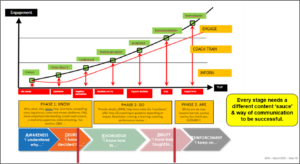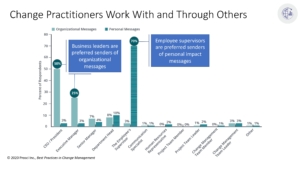Acknowledge the timing and how each phase requires a different communication ‘sauce.’
The relationship between senior management and employees during change is pivotal. To illustrate this, I often combine the Prosci ADKAR Model and Daryl Conner‘s Engagement Model.
![]()

This combination explains employees’ emotional needs and the timeline during a change initiative. It stresses the importance of addressing these emotions, offering support, and guiding employees through the process. The challenge lies in tailoring communication for each phase, from explaining the why, what, who, when, and how, to connecting these changes with daily activities, FAQs, workshops, and delving into specific details and lessons. However, we often provide a one-size-fits-all approach, typically only once.
Senior management should acknowledge the gap in navigating these change phases. Often, they launch the change long before employees become aware of it, placing them significantly ahead in the change process. While senior management might already be in the final phase of ensuring employee compliance with the novel changes, employees are often still in the initial, grappling with the “why” and “how.” Rushing them through these stages can make them feel forced and creates resistance to the change, directly contradicting senior management’s objectives.
There is also a concept gap. Senior management have a broader knowledge of the company’s eco system (prices, competition, suppliers, customer demands, financial, …) to better link to the why behind a change. Acknowledging this gap and addressing it is the way forward.
Change communication is ideally customized, simplified, and consistently reiterated, infused with empathy and patience. Corporate Communication and senior leaders should openly discuss the change, its reasons, and anticipated hurdles. They should translate the company’s eco-system and context, so employees understand the “why.”
Change without supporting people managers is doomed to fail.
Leadership plays a crucial and often underestimated their role during times of change. Leading employees through change is not an additional task but an integral part of a leader’s responsibilities. The below chart shows the importance of people managers as the most trustworthy (or the opposite) source of information regarding company changes. Yet each level has its own role to play.

Visionary Communication from our ‘corporate idols’: Employees desire senior leaders to inspire them with a compelling narrative that explains the ‘why’ behind the change. They should provide a clear and inspirational top-level story that outlines where we are headed and why we are going there. It is essential to establish belief and readiness to follow. Therefore, senior leaders should possess inspirational qualities, be skilled speakers, and have excellent storytelling abilities.
The WIFM (what is in it for me) translation from our People Manager or ‘influencer’ of our time. Direct managers play a critical role in translating that vision into actionable steps for their teams. They should provide the day-to-day operational guidance, answer questions, address concerns, and offer support. People Managers function as the bridge between the organizational vision and the team’s execution.
Change thrives when both leader levels are true change catalysts. By displaying their commitment and adaptability, prioritising the company’s future over the past. When employees witness their leaders actively engaging in and embracing change, it fosters confidence and motivation. Have you, as HR professionals, recently assessed the ‘resistance to change’ among your senior management? The Dinamo test is one I often recommend.
Also, my communication mantra is: ‘Everybody can talk, but good communication is a skill or capability.’
So, educate, support, or if necessary, tackle your senior leaders and people managers first and the battle is half won. This should primarily occur during times of ‘peace,’ not during ‘war,’ when it may be too late.
How? How? Equip people leaders with toolkits containing guidance and instructions for managing specific changes. These toolkits should encompass vital information, supportive slides, Q&A resources, change narratives, guidance on tone of voice, and desired actions and mindset outcomes. Additionally, offer training in areas like motivational speaking, engaging camera and audience presence, and leading teams through change.
In summary, successful change management relies on effective communication, strong leadership, and proactive support for leaders and managers during peaceful times.
Good luck with your change journeys!

